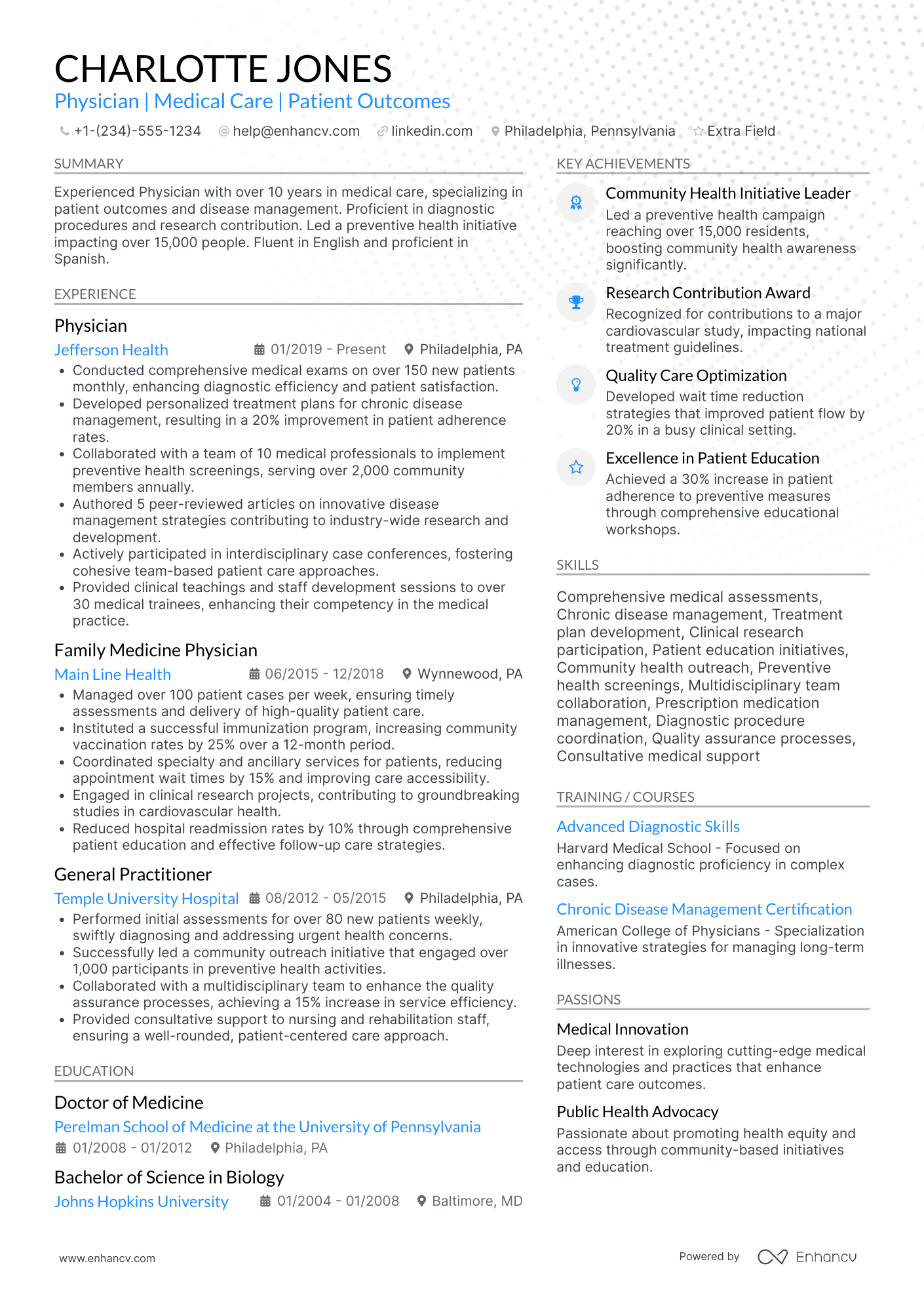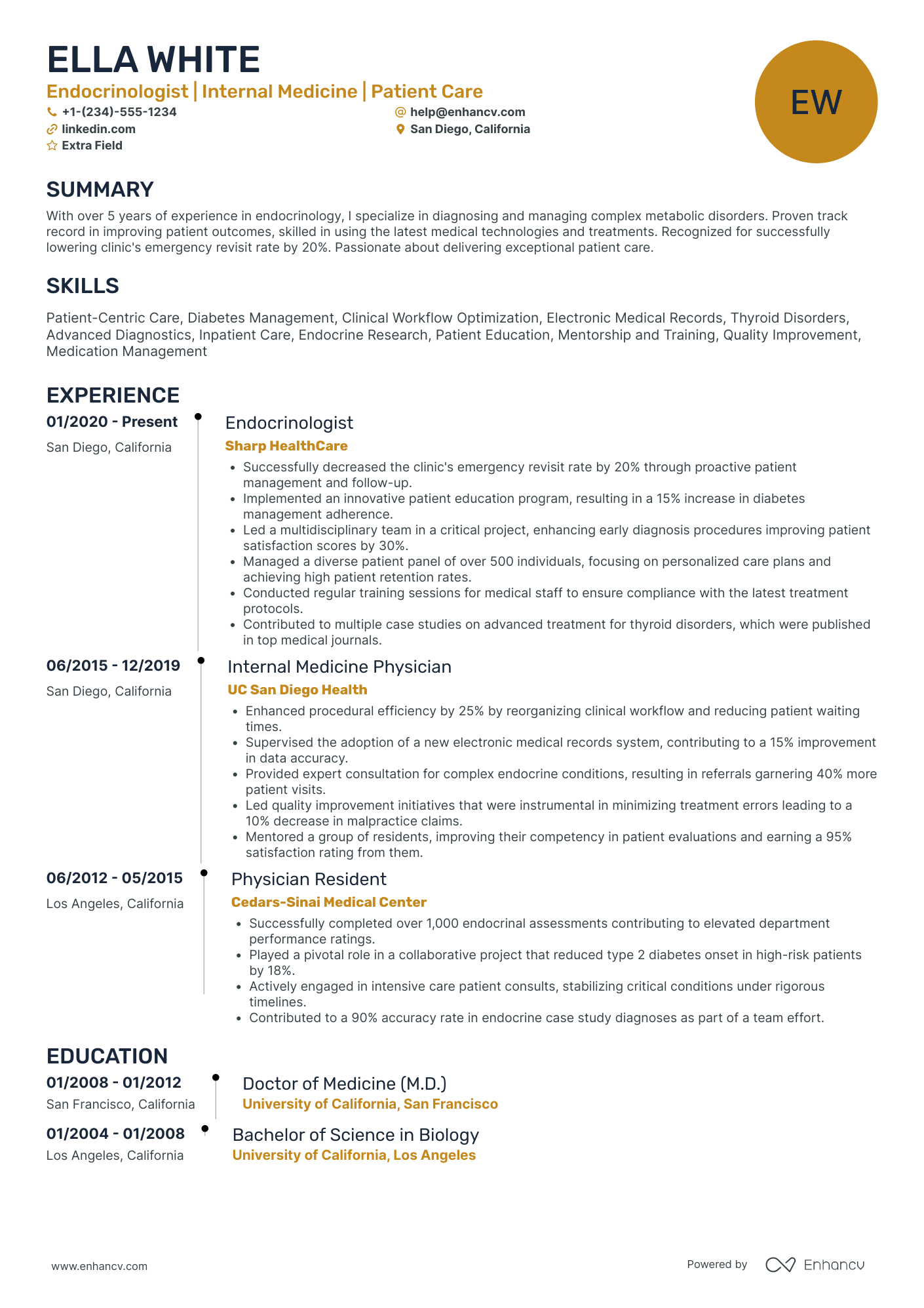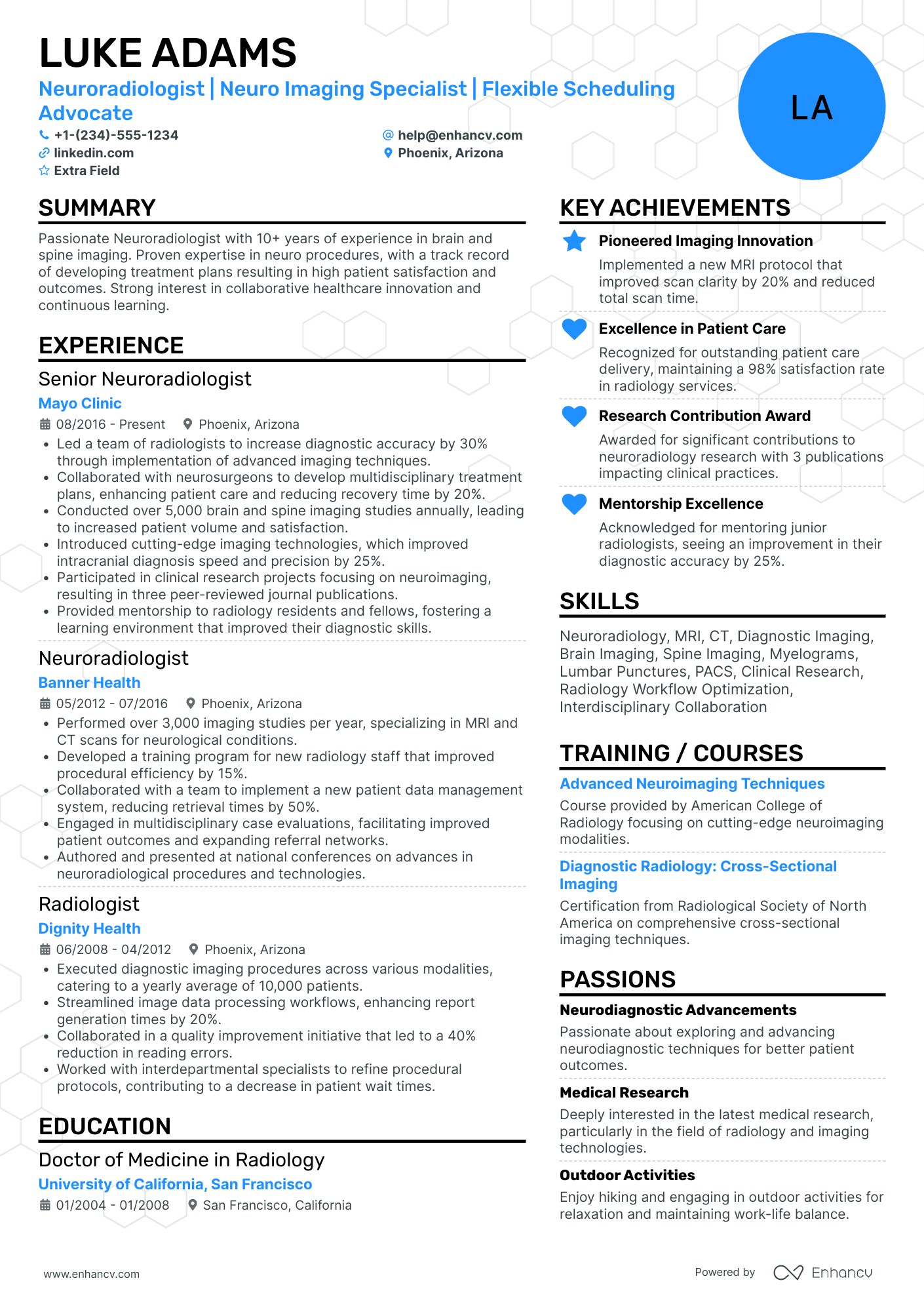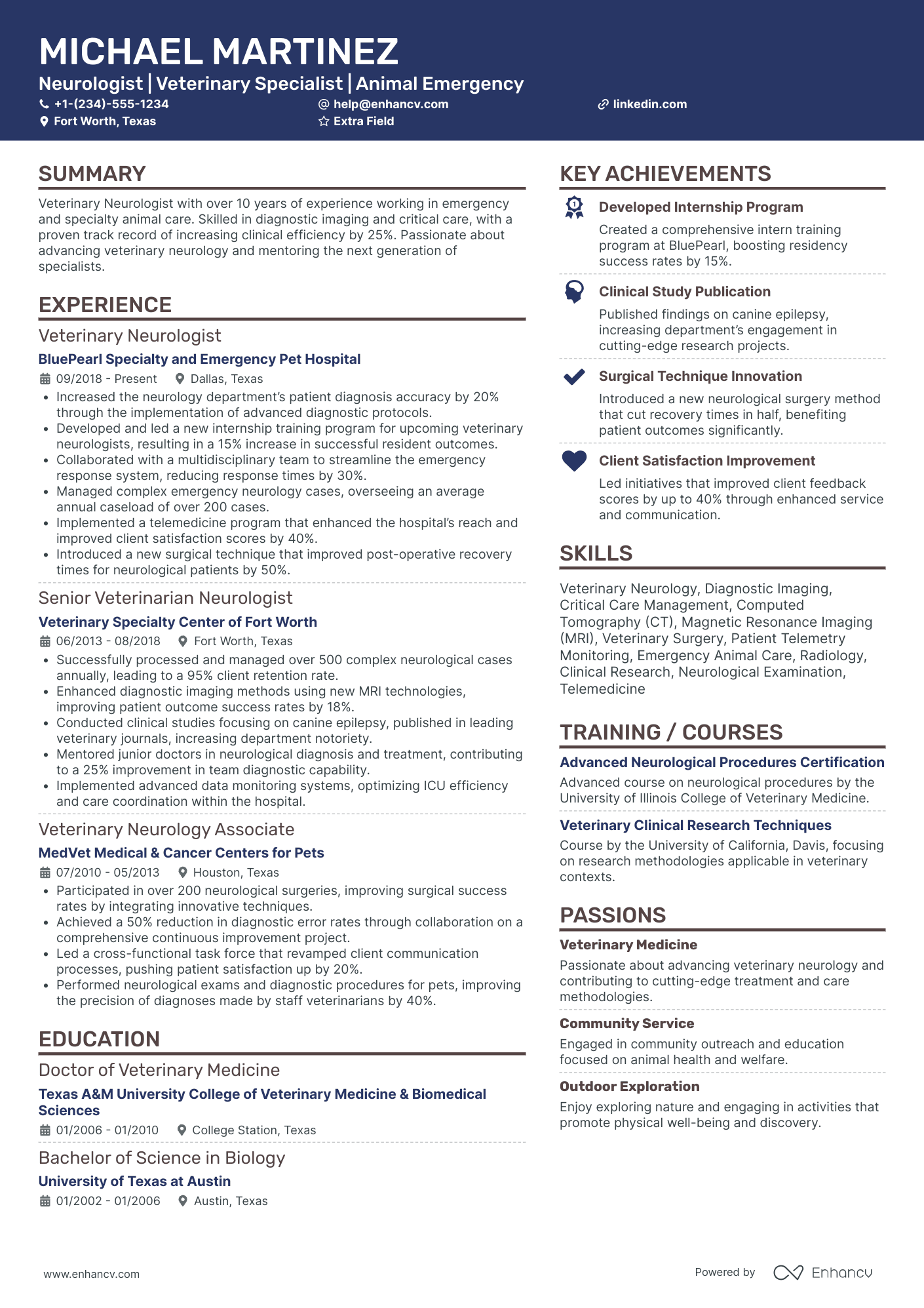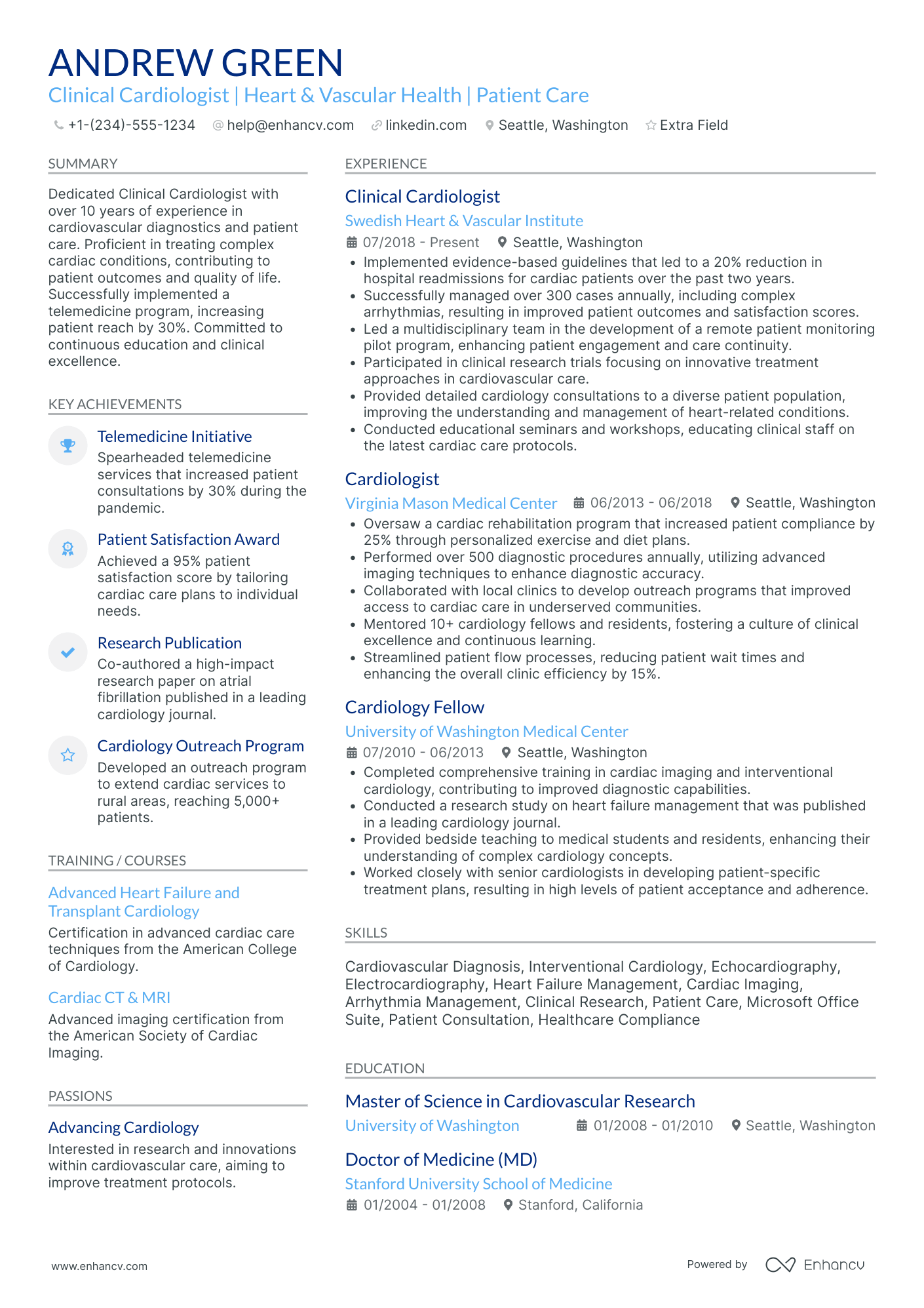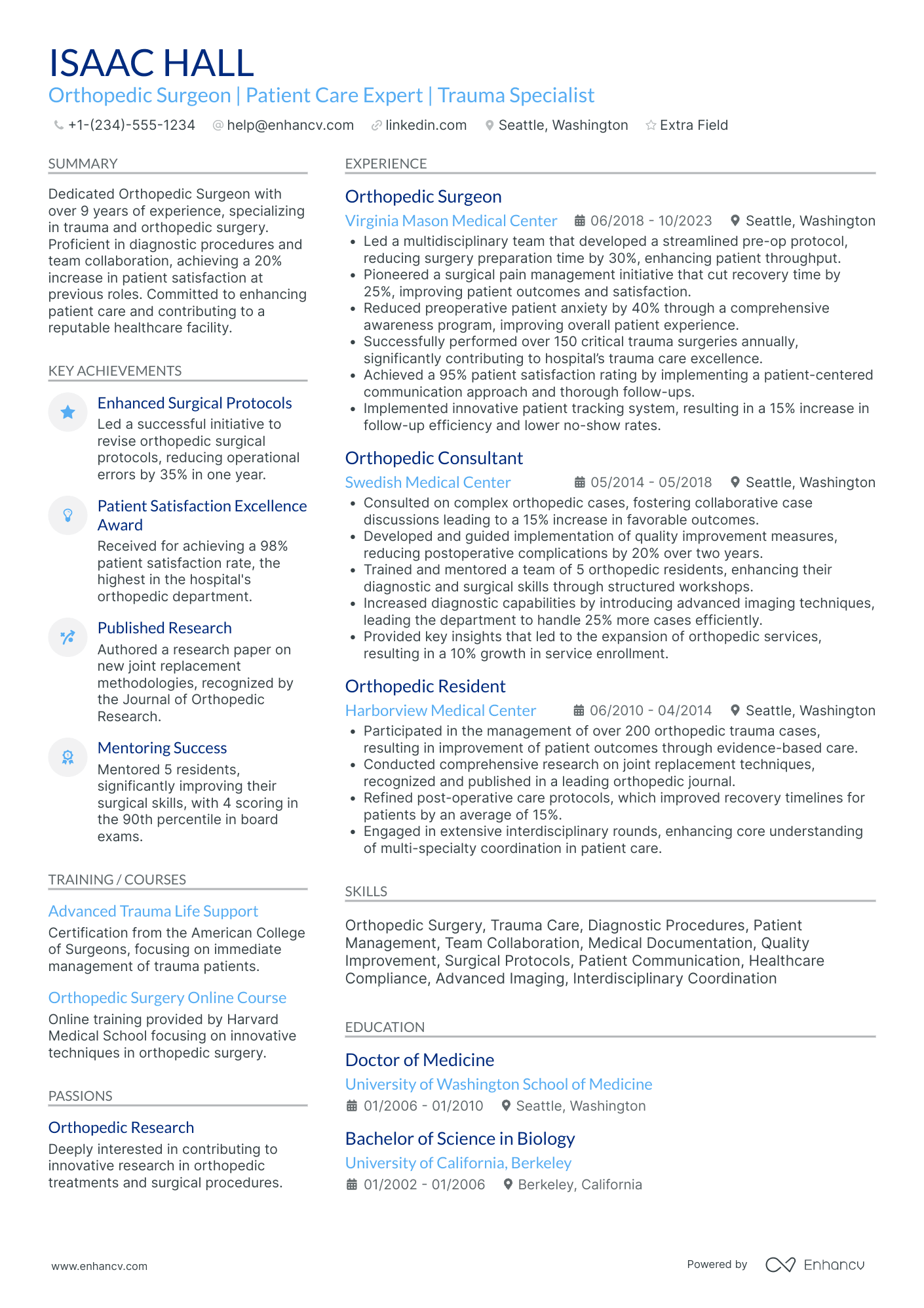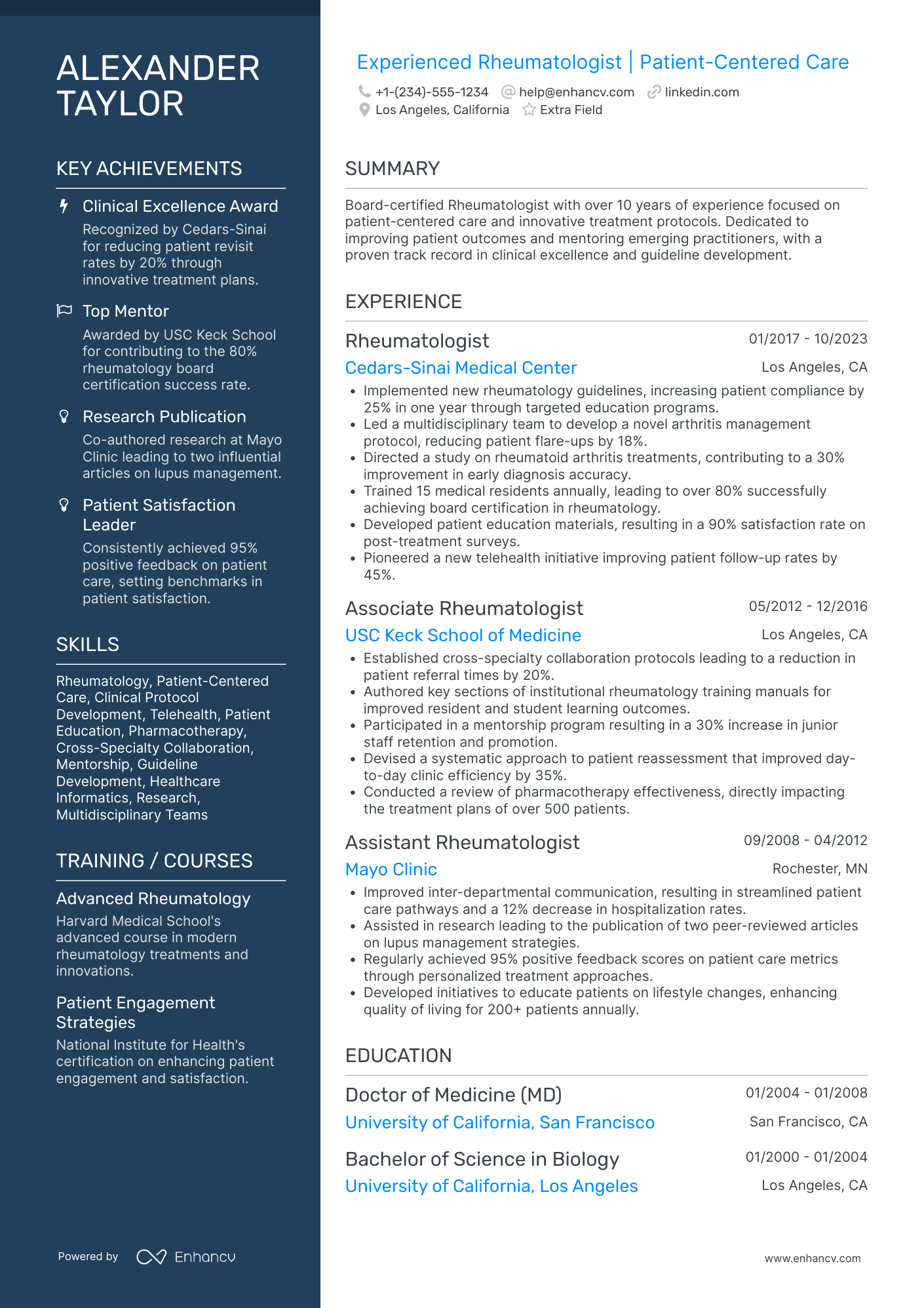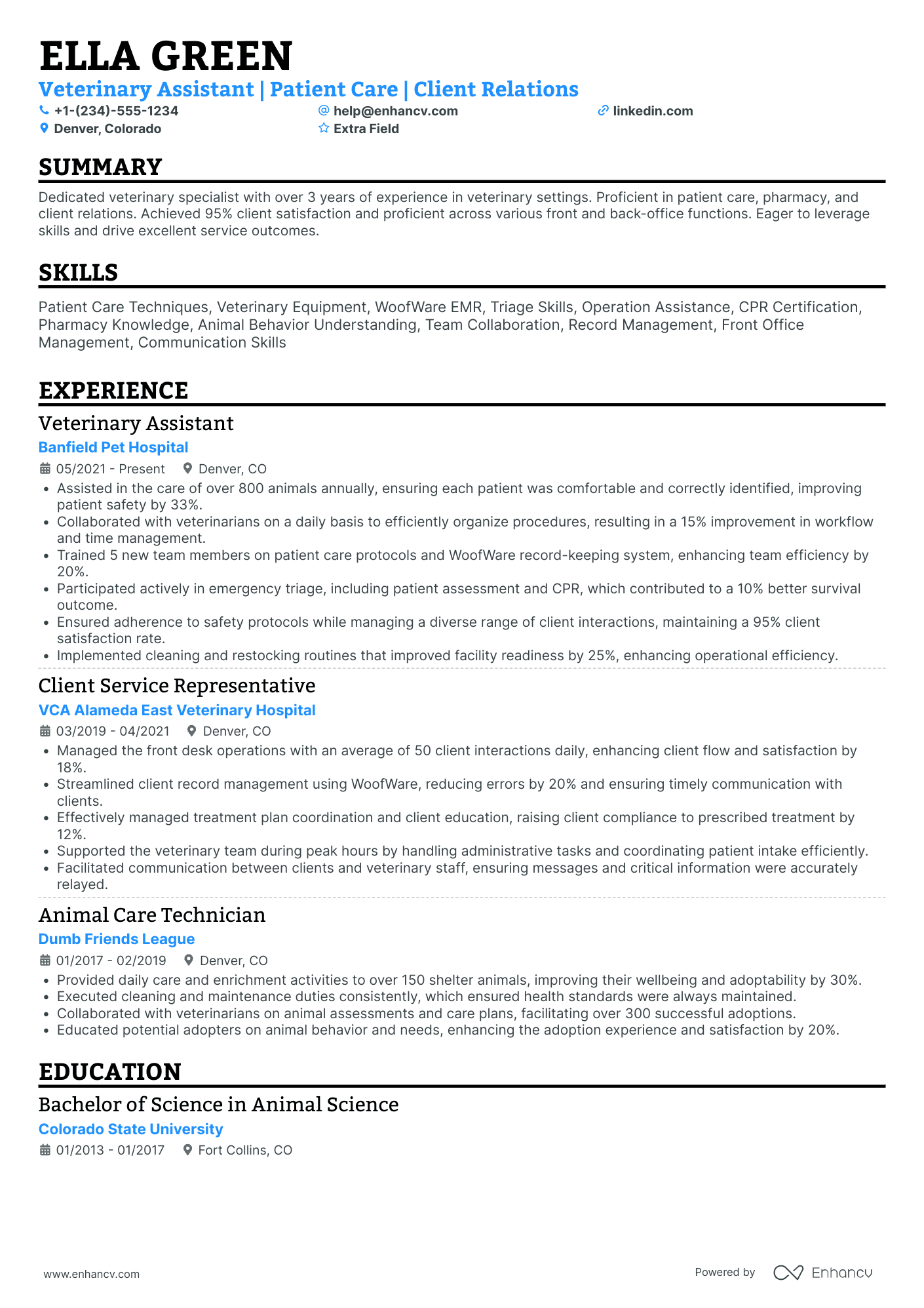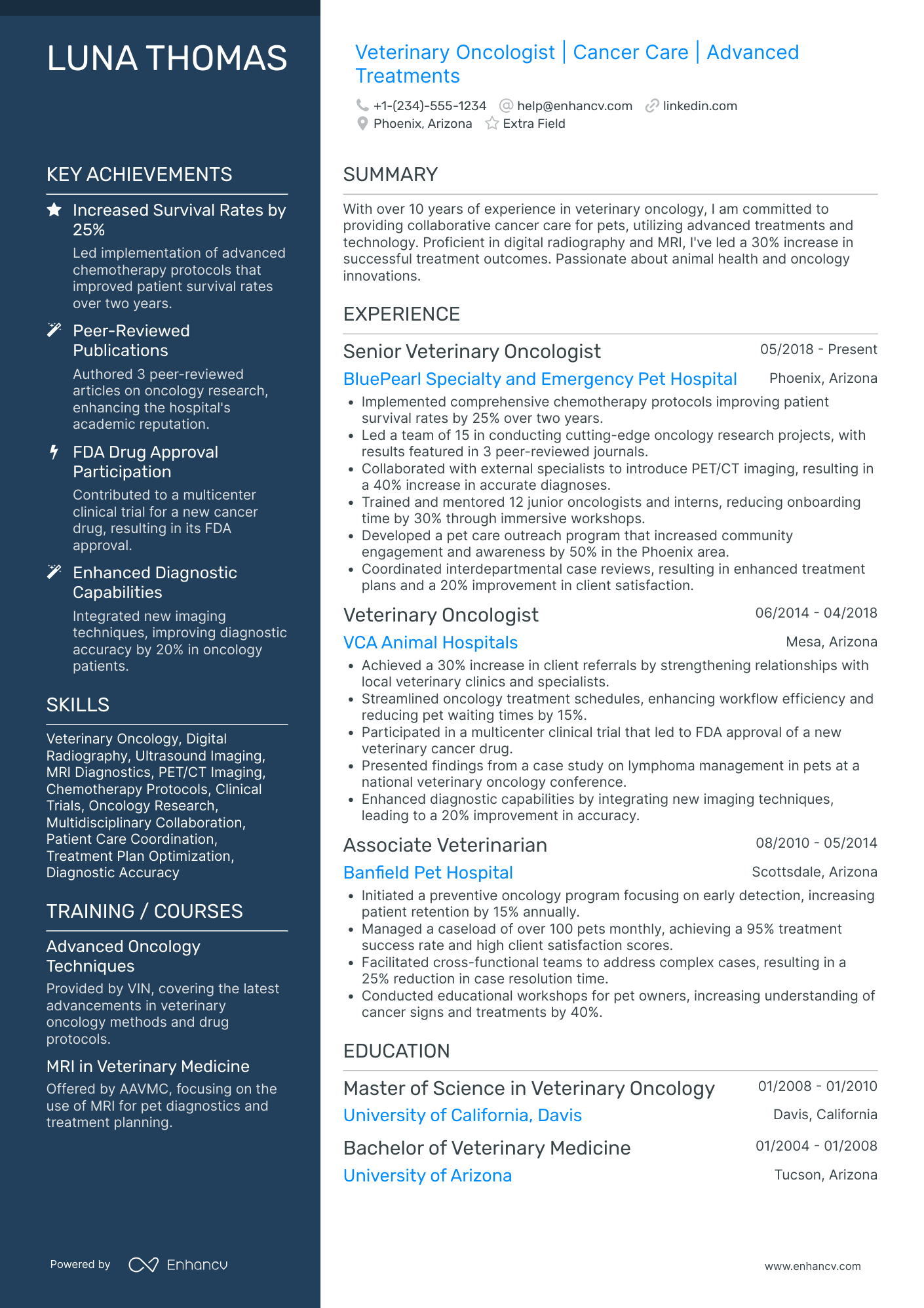Being a doctor requires a wide range of skills and abilities, not just medical knowledge.
You need training in your medical specialty and the right bedside manner to work with patients. Not to mention the years of extensive schooling required to do the job.
Your doctor resume must capture your clinical experience as well as your interpersonal skills.
We’ve taken the guesswork out of the process by creating a guide to help you create the best doctor resume possible.
In this guide, you’ll learn:
- How to highlight your medical specialties to separate yourself from other candidates and tailor your resume to your target job
- How to format your doctor’s resume so that recruiters can find the information they need quickly to see that you’re qualified
- How to keep every section of your resume concise so that your comprehensive background is conveyed with no wasted space
- How to keep your resume up-to-date to reflect your knowledge in the most current trends and technologies in the medical field
If you’re looking for a different role in the medical field, try browsing some of our related resume guides:
Doctor resume example
Here's what this applicant does well in their resume:
- Highlighting a proven track record in telemedicine and AI diagnostics: The resume emphasizes the applicant's significant experience in leveraging technology to improve healthcare delivery, particularly through telemedicine and AI diagnostics, which are critical skills in the current healthcare environment.
- Demonstrating impact through achievements: The applicant effectively showcases their achievements, such as implementing a new patient triage system that reduced wait times by 20%, leading a project to integrate AI diagnostics tools, and developing a community health program, all of which highlight their ability to deliver tangible improvements in patient care and healthcare efficiency.
- Detailing leadership and initiative in healthcare management: The resume details leadership roles and initiatives, such as spearheading public health initiatives, leading cross-functional teams, and initiating continuous education programs. This demonstrates the applicant's strong leadership skills and their proactive approach to healthcare management and education.
How to format a doctor resume
Format is the first thing recruiters notice when they look at a resume. Make a good impression and demonstrate your organizational skills with a doctor’s resume that’s clear and easy to read.
Doctors work in clinical environments where every detail matters. Show recruiters that you can communicate information efficiently and effectively with every section of your resume.
Consider these key elements for a doctor resume format that catches recruiters' attention:
- Reverse chronological layout - As the name suggests, a reverse chronological layout focuses on your work experience in reverse chronological order. Show that you are committed to your role and have gained clinical experience over time with a strong work history.
- Professional header - Include a header at the top of your resume that clearly states your title and professional contact information. Make a good introduction by including a certification or specialization associated with your role.
- Single page - doctors need to meet specific requirements, particularly in specialized fields. Save hiring managers time by limiting your doctor resume to your relevant skills and experience.
- ATS optimized - Select fonts and file formats that are optimized for Applicant Tracking Systems. Use Enhancv’s resume builder to accomplish all of the above and give your doctor’s resume the best chance of making it to a human recruiter.
The layout of a resume can differ by region – Canadian resumes may use a distinct format.
Is your resume good enough?
Drop your resume here or choose a file. PDF & DOCX only. Max 2MB file size.
The top sections on a doctor resume:
- Personal information: This section includes the contact information; it's essential as it helps recruiters to reach out.
- Career objective: An outlined career goal demonstrates commitment and personal direction aligned with the role.
- Medical licenses and certifications: Proof of eligibility to practice and additional qualifications unique to the medical field.
- Clinical experience and residencies: This showcases practical experience and past responsibilities in healthcare settings.
- Medical education and training: Highlights the scope of knowledge and specialization unique to the medical profession.
What recruiters want to see on your resume:
- Board certification: It asserts that the candidate meets nationally recognized standards for education, knowledge, and skills in medicine, ensuring quality patient care.
- Clinical experience: Practical experience in medical settings is valued as it confirms the candidate's ability to apply their knowledge successfully.
- Specialization: doctors with a specific area of expertise are often preferred as they bring in-depth knowledge and skills to the role.
- Publications and research: Involvement in research and having published works demonstrate intellectual curiosity and contribution to the medical field.
- Recommendations or references: They provide insights into the candidate's professional conduct and reputation within the healthcare community.
How to write your doctor resume experience
The experience section of your resume lists your work history along with 3-4 bullets highlighting your top accomplishments in the role. Show potential employers what you’ve achieved as a doctor while gaining clinical experience in the field with real patients.
Don’t just write a list of generic roles and responsibilities. Highlight specific instances where your skills were put to use and achieved results.
Let’s look at an example of a doctor’s resume experience section.
- •Treated patients and managed records
- •Listened to patients and provided compassionate care
- •Trained other doctors in new intake process
What doesn’t work in this example:
- No numbers: “Treated patients and managed records” misses an opportunity to convey the scope of work this candidate has experience with. Use real numbers and data to quantify past successes.
- No clear evidence: "Listened to patients and provided compassionate care" expects hiring managers to take the candidate’s word for it instead of showing specific examples. Don’t leave anything up to imagination and include clear evidence of your claims.
- Generic tasks: "Trained other doctors in new intake process" makes no mention of whether or not this had a positive outcome. Don’t just list generic duties. Highlight how you achieved success in your role.
Let’s make a few changes and take another look.
- •Treated an average of 30 patients per shift and managed records for 200 patients
- •Implemented feedback from patient survey, improved patient satisfaction by 30%
- •Trained other doctors in new intake process, improved intake efficiency by 20%
What works in this example:
- Quantifies impact: "Treated an average of 30 patients per shift and managed records for 200 patients" gives hiring managers a clear idea of this candidate’s experience and whether they are a good fit for the role.
- Evidence of success: "Implemented feedback from patient survey, improved patient satisfaction by 30%" shows how this candidate used their set of skills to achieve success on the job.
- Industry skills: "Trained other doctors in new intake process, improved intake efficiency by 20%" highlights how this candidate has gotten results in the industry and will impact success at their target company.
How to quantify impact on your resume
doctors need to highlight their most significant achievements, courses, clinical rotations, and research.
While certain accomplishments may not result in tangible outcomes, it’s important to quantify impact on your doctor’s resume with real numbers whenever possible.
Here are a few areas to consider when quantifying impact on your doctor’s resume:
- Include the number of patients seen daily: This indicates efficiency and the ability to handle high-pressure situations.
- Specify the number of procedures or surgeries performed: This highlights expertise and hands-on experience.
- Mention any percentage increase in patient satisfaction scores: This demonstrates commitment to quality patient care.
- Quantify the size of the medical team led or collaborated with: This will highlight leadership or teamwork skills.
- State the number of medical papers published: This shows contribution to the medical field and dedication to continuous learning.
- Cite any reduction in patient recovery time due to your actions: This indicates the ability to provide effective treatment.
- Provide the number of years of experience in the medical field: This emphasizes the maturity of your skills and knowledge.
- Indicate the number of medical conferences attended: This shows commitment to staying updated with the latest medical advancements.
How do I write a doctor resume with no experience
If you’re recently completed medical school and are seeking your first entry-level position as a doctor, then you need to highlight experiences outside of work history.
The best approach is to write a functional resume that focuses on transferable skills rather than experience to show potential employers how you’ve prepared for the role.
Highlight your extensive training in any specialties and other jobs where you’ve gained relevant skills in healthcare and patient services.
Follow these steps to write an effective entry-level doctor’s resume:
- Choose a functional resume layout
- Focus on transferable skills
- Present credentials and licenses clearly
- Tailor every section to fit your target job
Don’t pad your experience section with irrelevant jobs just to fill space. Only include roles that are relevant to your target position and focus on transferable skills.
How to list your hard skills and soft skills on your resume
doctors are skilled in a range of medical treatments and techniques, as well as the interpersonal skills necessary to provide compassionate care to patients.
Your doctor's resume will present your skills in two major categories.
Hard skills are the technical knowledge and abilities needed to perform job duties, whereas soft skills are the interpersonal and communication skills needed to interact with others.
Hard skills tend to be straightforward and can appear in a simple list form. Here is an example of hard skills on a doctor’s resume.
Only include hard skills that you’re proficient in and are relevant to your target job. Show potential employers that you have the right combination of skills to do the job.
Here are a few more hard skills to consider for your doctor’s resume.
Best hard skills for your doctor resume
- Patient Assessment
- Disease Diagnosis
- Surgical Skills
- Patient Management
- Administration of Medications
- Emergency Response
- Medical Coding
- CPR Certified
- Proficient in Electronic Medical Records (EMR) Technologies
- Proficient with Medical Imaging Technologies
- Knowledge of Latest Medical Equipment
- Advanced Cardiac Life Support (ACLS)
- Pediatrics
- OB/GYN Procedures
- Psychiatric Evaluation
- Expertise in Radiology
- Medical Software Proficiency
- Knowledge of Laboratory Procedures
- Advanced Knowledge of Drugs and Side Effects
- Pain Management Techniques
Soft skills can be open to interpretation and are most effective when provided with an example. Be specific in your soft skills and avoid overused buzzwords on your resume.
Here is an example of a soft skills section on a doctor’s resume.
Here are a few more soft skills to consider for your doctor’s resume.
Best soft skills for your doctor resume
- Communication Skills
- Empathy
- Patience
- Attention to Detail
- Problem Solving
- Decision Making
- Time Management
- Teamwork
- Leadership
- Adaptability
- Resilience
- Ability to Work under Pressure
- Professionalism
- Approachability
- Critical Thinking
- Self-Confidence
- Emotional Intelligence
- Integrity
- Cultural Competency
- Active Listening
How to list your certifications and education on your resume
Education requirements for doctors vary by specialization, but the general minimum requirements include an undergraduate degree in chemistry, biology, or similar field, followed by the completion of medical school and a residency program.
Your education section should include:
- Name of institution
- Name of degree
- Years attended
Let’s look at an example of a doctor's resume education section.
Your doctor certification section will include a medical license for your state and any additional specialties you’re certified in.
Here is an example of a certification section on a doctor’s resume.
The field of medicine continually evolves with new studies, techniques, and technologies emerging constantly.
Keeping up with these changes and continuously updating your resume to reflect this learning shows a commitment to your career and increases your employability.
Here are a few more certifications to consider for your doctor’s resume.
Best certifications for your doctor resume
How to write your doctor resume summary or objective
A summary or objective is an opportunity to introduce yourself and your value in the industry as a medical doctor. It captures your career history and top accomplishments in 3-4 sentences.
Though the terms are often used interchangeably, there is a slight difference between a summary and an objective.
A summary is a brief introduction that summarizes your career and top achievements. An objective looks to the future and captures what you are hoping to achieve in your new position.
A summary is more suitable for candidates with experience in the field. Entry-level candidates are more likely to focus on an objective.
If you have at least some experience in the field as a doctor, combine them by writing an introduction, a career highlight, and a goal you share with your target employer.
First, let’s take a look at a doctor’s resume summary example that is less effective.
What doesn’t work in this example:
- Unclear experience: “doctor with experience in pain management” doesn’t provide any specifics to show hiring managers what this candidate has accomplished. Use numbers and examples in your summary to get your message across clearly.
- General claims: “Skilled in sports recovery techniques and patient management” doesn’t speak to whether or not this candidate achieved any success in these areas. Take the opportunity to share a top career highlight.
- Blanket statements: “Seeking a new opportunity as lead physician” gives the impression that this resume is being mass-emailed to job openings. Tailor your resume to your target job so hiring managers know you did your research.
Let’s make a few changes and take another look.
What works in this example:
- Highlights specialty: "General Practitioner with 8 years of experience in pain management” shows the exact amount of experience this candidate has in the field. Show potential employers why you’re the right fit with a strong opening line.
- Quantifies impact: “Certified in sports recovery techniques and achieved 100% patient satisfaction rating” shows how this candidate has used their skills to achieve success. Potential employers want to see how you will impact success at their organization.
- Targeted goal: “Seeking the opportunity to leverage expertise as Lead Physician at Athletic Healing Associates” shows that this candidate has researched the company and is bringing solutions to their specific role.
Additional sections for a doctor resume
If you’ve developed medical skills outside of the traditional career path, you may want to find other ways to incorporate them into your resume.
Additional sections on your resume can be a great way to show how you’ve prepared to work as a doctor in unique ways.
Here are a few sections to consider adding to your doctor’s resume:
- Languages - Speaking more than one language can be a great skill for a doctor, especially if your service area covers a population where multiple languages are spoken.
- Continuing Education - With the medical field constantly advancing and evolving, doctors need to stay current on the latest trends and technologies. Increase your employability by updating your doctor’s resume with new industry knowledge.
- Volunteer Work - Volunteering is a great way to develop soft skills necessary for healthcare settings like crisis management, communication, and decision-making under pressure.
Key takeaways for writing a great doctor resume
You’re just about ready to send off that amazing doctor resume that gets callbacks! Before you go, let’s review a few key takeaways from this guide:
- Format your doctor resume so that hiring managers can find the information they need quickly and clearly.
- Present your education and licenses so recruiters know that you’re committed to your career and meet the requirements for the role.
- Highlight successes in the industry with real numbers and data to show how you will impact success at your target company.
- Focus on your best skills and relevant experiences to tailor your doctor’s resume to fit your target job.
Doctor resume examples
By Role






